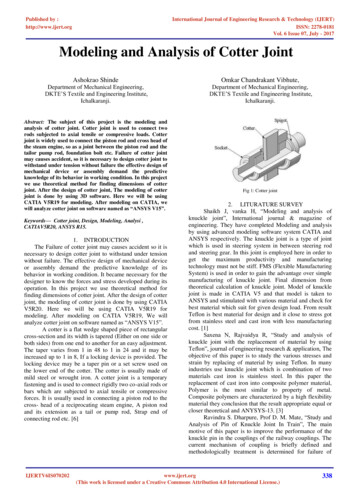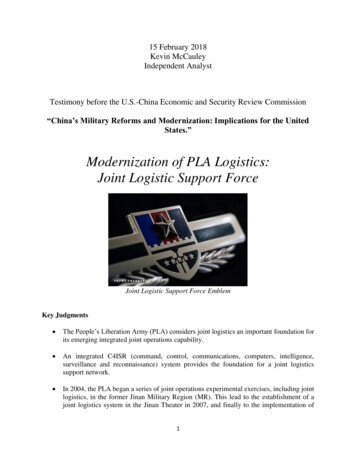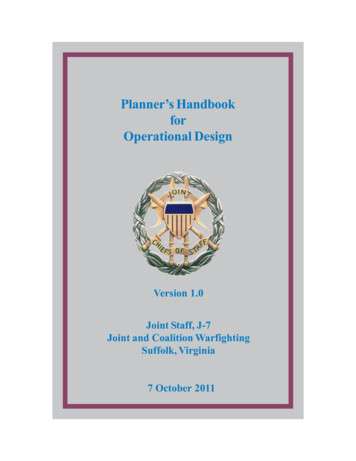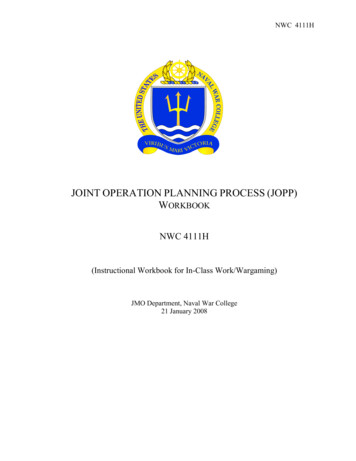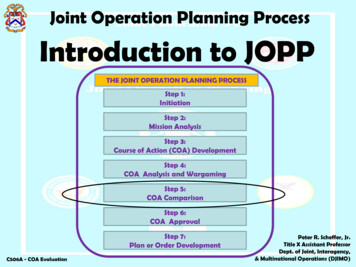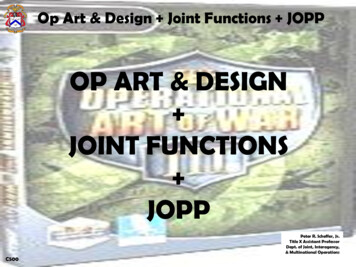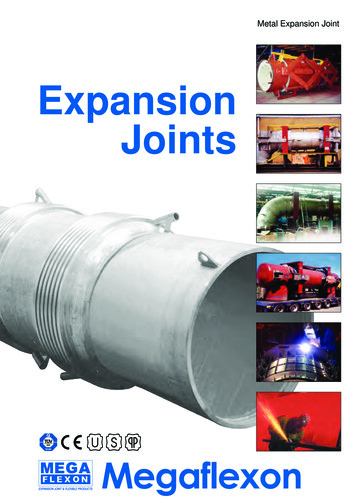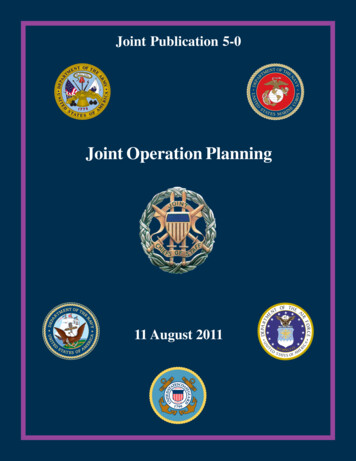
Transcription
Joint Publication 5-0Joint Operation Planning11 August 2011
This edition of Joint Publication (JP) 5-0, Joint Operation Planning, reflects thecurrent doctrine for conducting joint, interagency, and multinational planning activitiesacross the full range of military operations. This keystone publication forms the core ofjoint warfighting doctrine and establishes the framework for our forces’ ability to fight asa joint team.As our military continues to serve and protect our Nation in complex conflicts acrossthe globe, it is appropriate that we continue to refine our doctrine and update our planningpractices based upon experience and hard won knowledge. As a result of relevant jointforce experience and knowledge, the practice of operational design and its relationship tooperational art and the joint operations planning process is reflected in this revision ofJP 5-0.Likewise, the practice of Adaptive Planning and Execution has continued to evolvesince the last publication of JP 5-0. This volume provides necessary updates to thatprocess, as our combatant commands have continued to develop their ability to providemilitary options for contingencies and we seek to develop tools that allow for more rapiddevelopment, review, and refinement of plans at the accelerated pace we find the worldrequires today.Given the operational environment is not simple or static, adaptation and flexibilityare necessary in planning and execution. This edition of JP 5-0 seeks to arm joint forcecommanders with processes that allow for that flexibility. I encourage leaders to ensuretheir organizations understand and use joint doctrine and this manual in particular as youcontinue to assist our Nation in advancing its enduring interests.M. G. MULLENAdmiral, U.S. Navy
PREFACE1. ScopeJoint Publication 5-0, Joint Operation Planning, reflects current guidance for planningmilitary operations and, as a keystone publication, forms the core of joint doctrine for jointoperation planning throughout the range of military operations.2. PurposeThis publication has been prepared under the direction of the Chairman of the JointChiefs of Staff. It sets forth joint doctrine to govern the activities and performance of theArmed Forces of the United States in joint operations and provides the doctrinal basis forinteragency coordination and for US military involvement in multinational operations. Itprovides military guidance for the exercise of authority by combatant commanders and otherjoint force commanders (JFCs) and prescribes joint doctrine for operations, education, andtraining. It provides military guidance for use by the Armed Forces in preparing theirappropriate plans. It is not the intent of this publication to restrict the authority of the JFCfrom organizing the force and executing the mission in a manner the JFC deems mostappropriate to ensure unity of effort in the accomplishment of the overall objective.3. Applicationa. Joint doctrine established in this publication applies to the joint staff, commanders ofcombatant commands, subunified commands, joint task forces, subordinate components ofthese commands, the Services, and combat support agencies.b. The guidance in this publication is authoritative; as such, this doctrine will befollowed except when, in the judgment of the commander, exceptional circumstances dictateotherwise. If conflicts arise between the contents of this publication and the contents ofService publications, this publication will take precedence unless the Chairman of the JointChiefs of Staff, normally in coordination with the other members of the Joint Chiefs of Staff,has provided more current and specific guidance. Commanders of forces operating as part ofa multinational (alliance or coalition) military command should follow multinational doctrineand procedures ratified by the United States. For doctrine and procedures not ratified by theUnited States, commanders should evaluate and follow the multinational command’sdoctrine and procedures, where applicable and consistent with US law, regulations, anddoctrine.i
PrefaceIntentionally BlankiiJP 5-0
SUMMARY OF CHANGESREVISION OF JOINT PUBLICATION 5-0DATED 26 DECEMBER 2006 Reorders and reorients chapters to provide a more logical flow and better reflectplanning practice today. Adds additional appendices to provide ready reference for best practices andprocess specificity. Includes the new planning construct introduced in the 2008 Guidance forEmployment of the Force. Reflects the Department of Defense’s evolution from Joint Operation Planning andExecution System (JOPES) to Adaptive Planning and Execution (APEX) system. Integrates concept of ‘Design’ into existing joint doctrine on operational art,operational design, and the joint operation planning process. Reintroduces the term deliberate planning to cover all plans developed in noncrisis situations. Reduces redundancies and improves continuity between joint publication (JP) 5-0and JP 1, Doctrine for the Armed Forces of the United States. Reduces redundancies and improves continuity between JP 5-0 and JP 3-0, JointOperations.iii
Summary of ChangesIntentionally BlankivJP 5-0
TABLE OF CONTENTSPAGEEXECUTIVE SUMMARY . ixCHAPTER IROLE OF JOINT OPERATION PLANNING Overview. I-1Strategic Direction . I-2Providing Common Basis for Understanding and Adaptation . I-3Creating Understanding and Reducing Uncertainty . I-5Providing Options, Aligning Resources, and Mitigating Risks . I-5Constant Change, Learning, and Adaptation . I-6CHAPTER IISTRATEGIC DIRECTION AND JOINT OPERATION PLANNING Strategic Guidance and Planning Overview .II-1Section A. National, Defense, and Military Guidance.II-2 Introduction.II-2 National Security Council System .II-2 National Security Strategy .II-2 Department of Defense .II-3 Joint Strategic Planning System .II-4 Geographic Combatant Commanders .II-6 Interagency Considerations .II-8 Strategic Communication .II-9 Strategic Guidance for Multinational Operations .II-10Section B. Application of Guidance .II-11 Joint Planning and Execution Community .II-11 Adaptive Planning and Execution System .II-13 Operational Activities .II-14 Planning Functions .II-19 Deliberate and Crisis Action Planning Products .II-21Section C. Interorganizational Planning and Coordination .II-35 Interagency Planning and Coordination .II-35 Multinational Planning and Coordination .II-37 Review of Multinational Plans .II-38v
Table of ContentsCHAPTER IIIOPERATIONAL ART AND OPERATIONAL DESIGN Introduction. III-1The Commander’s Role . III-2Section A. Developing the Operational Approach . III-5 Overview. III-5 Methodology . III-7Section B. Elements of Operational Design . III-18 Overview. III-18 Elements of Operational Design . III-18Section C. Phasing . III-38 Application . III-38 Number, Sequence, and Overlap . III-40 Transitions . III-40 Phasing Model . III-41Section D. Assessment . III-44 Overview. III-44 Application . III-44CHAPTER IVJOINT OPERATION PLANNING PROCESS Introduction. IV-1Operational Art and Operational Design Interface with theJoint Operation Planning Process . IV-1Planning Initiation . IV-2Mission Analysis . IV-4Course of Action Development . IV-17Course of Action Analysis . IV-27Course of Action Comparison . IV-36Course of Action Approval . IV-40Plan or Order Development . IV-44APPENDIXABCDEFGHviJoint Operation Plan Format . A-1Strategic Estimate .B-1Staff Estimates.C-1Assessment . D-1Flexible Deterrent Options . E-1Flexible Response Options . F-1Course of Action Comparison . G-1Global Force Management . H-1JP 5-0
Table of ContentsJKReferences .J-1Administrative Instructions . K-1GLOSSARYPart I Abbreviations and Acronyms . GL-1Part II Terms and Definitions . 1IV-2IV-3IV-4IV-5IV-6IV-7IV-8IV-9IV-10Adaptive Planning Review and Approval Process . I-4National Strategic Direction .II-5Shaping of Theater Strategy .II-8Additional Sources of Strategic Guidance .II-10Joint Planning and Execution Community .II-12Joint Operation Planning Activities, Functions, and Products .II-14Planning During Execution .II-18Plans Relationship .II-22Deliberate Planning and Crisis Action Planning Comparison .II-30Crisis Action Planning .II-31Types of Orders .II-34Operational Art . III-2Developing the Operational Approach . III-3Operational Art and Planning Continuum . III-4Understanding the Operational Environment . III-8Political, Military, Economic, Social, Information, andInfrastructure System Analysis . III-10Defining the Problem . III-12Developing the Operational Approach . III-14Operational Approach—Example . III-15Elements of Operational Design . III-18End State, Objectives, Effects, Tasks . III-21Characteristics of Centers of Gravity . III-23Center of Gravity Analysis Example . III-25Sample Line of Operation . III-27Sample Lines of Effort . III-29Direct and Indirect Approach . III-32Notional Operation Plan Phases . III-39Phasing Model . III-41Joint Operation Planning Process . IV-2Joint Operation Planning . IV-3Mission Analysis . IV-5Mission Analysis Activities . IV-6Commander’s Critical Information Requirements . IV-12Example Mission Analysis Briefing . IV-15Course of Action Development . IV-17Step-By-Step Approach to Course of Action Development . IV-20Example Course of Action Development Briefing . IV-26Course of Action Analysis . IV-28vii
Table of ial Evaluation Criteria . IV-31Sample Wargaming Steps . IV-33Course of Action Comparison . IV-37Staff Estimate Matrix (Intelligence Estimate) . IV-38Course of Action Approval . IV-40Sample Course of Action Briefing Guide . IV-41Commander’s Estimate . IV-44Plan Development Activities . IV-47Functional Staff Estimates .C-2Assessment Levels and Measures . D-7Examples of Requested Diplomatic Flexible Deterrent Options . E-1Examples of Requested Informational Flexible Deterrent Options . E-2Examples of Requested Military Flexible Deterrent Options . E-3Examples of Requested Economic Flexible Deterrent Options . E-3Flexible Response Option Content Guidelines . F-2Flexible Response Option Scalability . F-4Example Numerical Comparison . G-2Example #2 Course of Action Comparison Matrix Format . G-3Criteria for Strengths and Weaknesses Example . G-4Descriptive Comparison Example . G-4Plus/Minus/Neutral Comparison Example . G-5Force Structure (Force Pool) . H-5JP 5-0
EXECUTIVE SUMMARYCOMMANDER’S OVERVIEW Discusses the Role of Joint Operations Planning Explains the Adaptive Planning and Execution (APEX) System Explains the Composition of Strategic Direction and Joint OperationPlanning Describes Operational Art, Operational Design, the Design Elements, and theRelationship to Joint Operation Planning Process Describes Joint Operation Planning ProcessRole of Joint Operation PlanningJoint Operation PlanningJoint operation planning consists of planningactivities associated with joint military operations bycombatant commanders (CCDRs) and their subordinatejoint force commanders (JFCs) in response tocontingencies and crises. It transforms nationalstrategic objectives into activities by development ofoperational products that include planning for themobilization, deployment, employment, sustainment,redeployment, and demobilization of joint forces.Strategic DirectionStrategic direction is the common thread thatintegrates and synchronizes the planning activities andoperations of the Joint Staff (JS), combatant commands(CCMDs), Services, JFCs, combat support agencies(CSAs), and other Department of Defense (DOD)agencies. It provides purpose and focus to the planningfor employment of military force. As an overarchingterm, strategic direction encompasses the processes andmanner by which the President and the Secretary ofDefense (SecDef) provide strategic guidance to thejoint force.Providing Common Basis forUnderstanding andAdaptationJoint operation planning occurs within AdaptivePlanning and Execution (APEX), which is thedepartment-level system of joint policies, processes,procedures, and reporting structures. APEX issupported by communications and informationtechnology that is used by the joint planning andix
Executive SummaryClear strategic guidance andfrequent interaction amongsenior leaders, combatantcommanders (CCDRs), andsubordinate joint forcecommanders (JFCs) promotesearly understanding of, andagreement on, strategic andmilitary end states, objectives,planning assumptions, risks,and other key factors.execution community (JPEC) to monitor, plan, andexecute mobilization, deployment, employment,sustainment, redeployment, and demobilizationactivities associated with joint operations. APEXformally integrates the planning activities of the JPECand facilitates the JFC’s seamless transition fromplanning to execution during times of crisis. APEXactivities span many organizational levels, but the focusis on the interaction between SecDef and CCDRs,which ultimately helps the President and SecDef decidewhen, where, and how to commit US military forces.Creating Understanding andReducing UncertaintyIn conducting joint operation planning, commandersand staff apply operational art to operational designusing the joint operation planning process (JOPP).Planners apply operational design to provide theconceptual framework that will underpin jointoperation or campaign plans and their subsequentexecution. The application of operational art andoperational design further reduces uncertainty andadequately orders complex problems to allow for moredetailed planning.Providing Options, AligningResources, and MitigatingRisksThe planning staff uses JOPP to conduct detailedplanning to fully develop options, identify resources,and identify and mitigate risk. Planners develop theconcept of operations (CONOPS), force plans,deployment plans, and supporting plans that containmultiple options in order to provide the flexibility toadapt to changing conditions and remain consistentwith the JFC’s intent.Constant Change, Learning,and AdaptationJoint operation planning plays a fundamental role insecuring the Nation’s interests in a continuouslychanging operational environment. Through structuredreview, assessment, and modification, plans areconstantly assessed and updated by the JFC andreviewed by the broader JPEC and senior DODleadership. The open and collaborative planningprocess provides common understanding acrossmultiple levels of organizations and the basis foradaptation and change.xJP 5-0
Executive SummaryStrategic Direction and Joint Operation PlanningStrategic Guidance andPlanning OverviewJoint plans and orders are developed with the strategicand military end states in mind. The commander andplanners derive their understanding of those end statesfrom strategic guidance. Joint operation planning is anadaptive process.It occurs in a networked,collaborative environment, which requires dialogueamong senior leaders, concurrent and parallel plandevelopment, and collaboration across multipleplanning levels. Clear strategic guidance and frequentinteraction between senior leaders and plannerspromote an early, shared understanding of the complexoperational problem presented, strategic and militaryend states, objectives, mission, planning assumptions,considerations, risks, and other key guidance factors.National, Defense, andMilitary GuidanceThe National Security Council (NSC) is the President’sprincipal forum for considering national security andforeign policy matters with the senior national securityadvisors and cabinet officials.For DOD, thePresident’s decisions drive strategic guidancepromulgated by the Office of the Secretary of Defense(OSD) and refined by the Joint Strategic PlanningSystem (JSPS). To carry out Title 10, United StatesCode (USC), statutory responsibilities, the Chairman ofthe Joint Chiefs of Staff (CJCS) utilizes the JSPS toprovide a formal structure in aligning ends, ways, andmeans, and to identify and mitigate risk for the militaryin shaping the best assessments, advice, and directionof the Armed Forces for the President and SecDef.National Security CouncilSystemThe NSC system is the principal forum for interagencydeliberation of national security policy issues requiringPresidential decision. The NSC prepares nationalsecurity guidance that, with Presidential approval,becomes national security policy, and whenimplemented, these policy decisions provide theguidance for military planning and programming.National Security Strategy(NSS)The National Security Strategy (NSS) is acomprehensive report required annually by Title 50,USC, Section 404a. It is prepared by the executivebranch of the government for Congress and outlines themajor national security concerns of the US and how theadministration plans to address them using allxi
Executive Summaryinstruments of national power. The document ispurposely general in content, and its implementationrelies on elaborating guidance provided in supportingdocuments (such as the National Defense Strategy[NDS], the Guidance for Employment of the Force[GEF], and the National Military Strategy [NMS]).Department of DefenseNational Defense Strategy. The NDS addresses howthe Armed Forces of the United States will fight andwin America’s wars and describes how DOD willsupport the objectives outlined in the NSS. It alsoprovides a framework for other DOD strategicguidance, specifically on deliberate planning, forcedevelopment, and intelligence.Existing legislation requiresSecretary of Defense (SecDef)to conduct a QuadrennialDefense Review (QDR) and tosubmit a report on the QDR toCongress every four years.Quadrennial Defense Review (QDR). The QDRarticulates a national defense strategy consistent withthe most recent NSS by defining force structure,modernization plans, and a budget plan allowing themilitary to successfully execute the full range ofmissions within that strategy.The Unified Command Plan,signed by the President, setsforth basic guidance to allCCDRs.Unified Command Plan (UCP). The UCP establishesCCMD missions and responsibilities; addressesassignment of forces; delineates geographic areas ofresponsibility for geographic combatant commanders(GCCs); and specifies responsibilities for functionalcombatant commanders (FCCs).Guidance for Employment of the Force. The GEFprovides two-year direction to CCMDs for operationalplanning, force management, security cooperation, andposture planning. The GEF is the method throughwhich OSD translates strategic priorities set in the NSS,NDS, and QDR into implementable direction foroperational activities.Joint Strategic PlanningSystem (JSPS)The JSPS is the primary system by which the CJCS, incoordination with the other members of the Joint Chiefsof Staff (JCS) and the CCDRs, conducts deliberateplanning and provides military advice to the Presidentand SecDef.JSPS products—such as theNational Military Strategyand the Joint StrategicNational Military Strategy. The NMS, derived fromthe NSS and NDS, prioritizes and focuses the efforts ofthe Armed Forces of the United States while conveyingxiiJP 5-0
Executive SummaryCapabilities Plan—provideguidance and instructions onmilitary policy, strategy, plans,forces, and resourcerequirements and allocationsessential to successfulexecution of the NSS andother Presidential directives.the CJCS’s advice with regard to the securityenvironment and the necessary military actions toprotect vital US interests. The NMS defines thenational military objectives (i.e., ends), how toaccomplish these objectives (i.e., ways), and addressesthe military capabilities required to execute the strategy(i.e., means).Joint Strategic Capabilities Plan (JSCP). The JSCPis the primary vehicle through which the CJCSexercises responsibility for directing the preparation ofjoint plans. The JSCP provides military strategic andoperational guidance to CCDRs, Service Chiefs,CSAs, and applicable defense agencies for preparationof campaign plans and contingency plans based oncurrent military capabilities. It serves as the linkbetween strategic guidance provided in the GEF andthe joint operation planning activities and products thataccomplish that guidance.Global Force Management ImplementationGuidance (GFMIG).The GFMIG integratescomplementary assignment, apportionment, andallocation information into a single GFM document.GFM aligns force assignment, apportionment, andallocation methodologies in support of the NDS, jointforce availability requirements, and joint forceassessments. It provides comprehensive insights intothe global availability of US military resources andprovides senior decision makers a process to quicklyand accurately assess the impact and risk of proposedchanges in forces assignment, apportionment, andallocation.Geographic CombatantCommandersStrategic Estimate. The strategic estimate is a toolavailable to CCMDs and subunified commands as theydesign and develop campaign plans and subordinatecampaign plans or operation plans (OPLANs). CCDRsuse strategic estimates developed in peacetime tofacilitate the employment of military forces across therange of military operations.Theater Strategy. GCCs develop a theater strategyfocused on achieving specified end states for theirtheaters. A theater strategy is a broad statement of thecommander’s long-term vision for the area ofxiii
Executive Summaryresponsibility. It i
Includes the new planning construct introduced in the 2008 Guidance for Employment of the Force. Reflects the Department of Defense's evol ution from Joint Operation Planning and Execution System (JOPES) to Adaptive Pl anning and Execution (APEX) system. Integrates concept of 'Design' into existing joint doctrine on .


